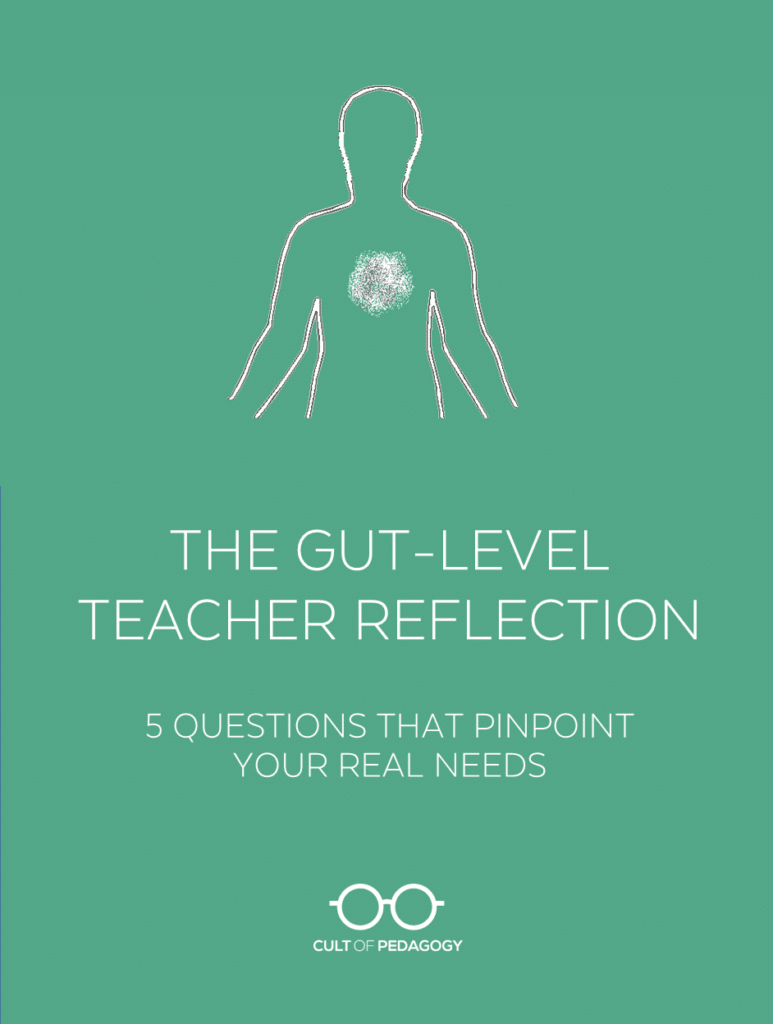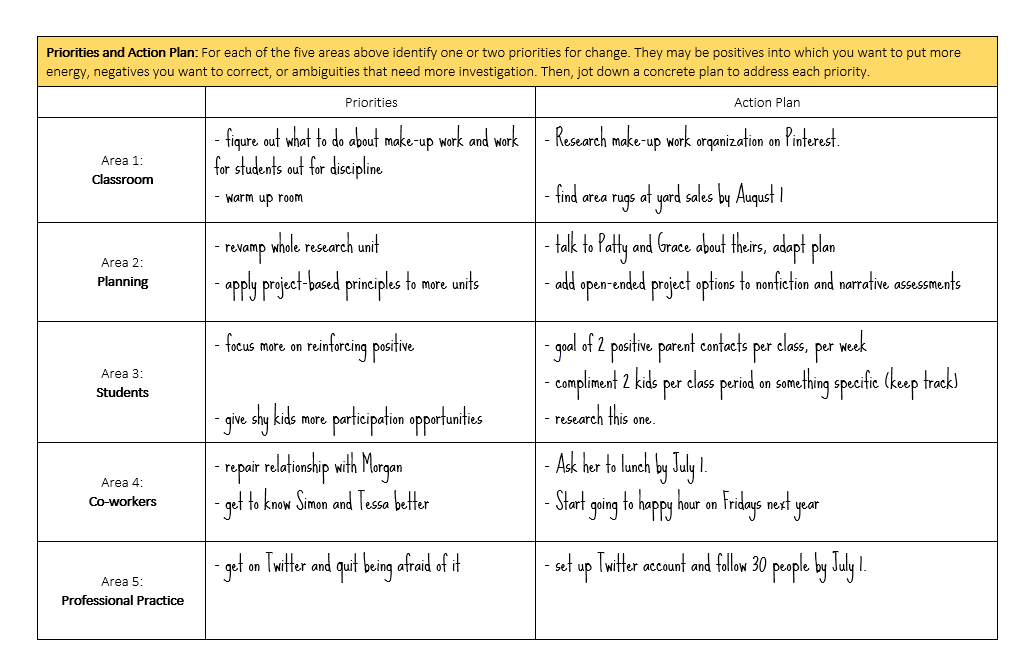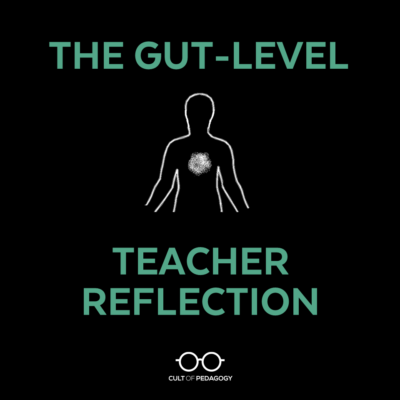
Listen to this post as a podcast:
Sometimes I will be going about my normal day and I’ll notice a negative haze has descended on me — some vague feeling of apprehension, guilt, or maybe self-pity — but I won’t have a clue where it came from. If I ignore this feeling, it just gets worse. But if I stop and try to trace it back to where it came from, I can usually pinpoint something: An off-the-cuff comment that sparked jealousy. A news preview that spun me into a worry spiral. The facial expression of an acquaintance that planted a seed of insecurity. Once I nail down the source of a bad feeling, I can think it through and make a plan to deal with it.
This practice can be applied to our teaching as well. The end of a school year is a natural time to reflect, and while it’s easy to find good questions for reviewing accomplishments and setbacks, I believe that to learn as much as possible from a reflection on your teaching, you have to let your gut talk, too.
Here are five questions that can help you listen to your body’s emotional responses and uncover problem areas in your teaching. Use when the year is done, before the start of a new semester, or any time it feels like things aren’t going well, but you just can’t figure out why. They will work best if you process them at a quiet time, when you can do each one slowly. If that’s not possible, just looking over the questions should sharpen your awareness of how your body responds to the different facets of your work.
[Download these questions in a free worksheet from my store at Teachers Pay Teachers]
1. Look around your classroom (or picture it in your mind). What parts of the room make you feel tense, anxious, or exhausted? What parts make you feel calm, happy, or proud?
Sometimes the reasons for these feelings will be clear — your back table is always cluttered, the traffic patterns in one part of the room were awful, a particular shelf contains materials that never got used, for an activity that never ended up happening. In other cases, the reasons may be deeper: You were hanging that poster right before you gave your class the worst yelling you’ve ever unleashed. Two kids got into a fight right by the pencil sharpener. The classroom phone reminds you of a terrible call you received.
After considering all parts of your room, pick 2 to 3 hot spots that need the most attention. These should be your priorities for change.
2. Open up your plan book (or spreadsheet, or wherever you keep your lesson plans from the year) and just start browsing, paying attention to how you’re feeling as your eyes meet certain events. What days and weeks give you a lift when you see them, a feeling of pride or satisfaction? Which ones make you feel disappointed, irritated or embarrassed?
You may not know exactly what made certain lessons great and others not so great, but your gut-level reaction will tell you there’s something to investigate. Did you take a risk that paid off in some exhilarating learning gains? Did you try something new that completely flopped? Do you see a lot of the same thing, over and over again? Were there times when your plans fell apart because you said yes when you should have said no?
Try to find common themes or patterns. What changes do you need to make so you feel less stressed about your workload, and more satisfied about how you design your students’ learning experiences?
3. Take a look at your student roster. What do you feel when you see each name? Which names make you feel relaxed, satisfied and proud, which ones make your chest tighten with regret, and which ones make your stomach tense?
Look for patterns here, too. If several students give you the same bad feeling, try to find the common thread between them. Is there a hole in your classroom management style? Are there quiet, well-behaved students you haven’t given much attention to? Do you need to learn more about working effectively with minority students? Do you lack confidence when working with students with autism?
Once you have identified some themes in the relationships you have with your students, choose 2 to 3 areas where you need to grow. And next year, consider collecting student feedback in a systematic way.
4. Mentally travel from classroom to classroom, picturing each teacher in the building. What are your feelings as you approach each one? Which coworkers give you a generally positive feeling, which ones are neutral, and which ones make you feel nervous, angry, or annoyed?
Your relationships with your colleagues have a huge impact on how you feel about coming to work every day. Are there Marigolds and Walnut Trees in your midst that you’ve never identified? Are there some strong, positive teachers in the building whom you feel intimidated by, but should probably get to know better? Is it time to fix a relationship that has been damaged?
After going through the faculty and staff, choose a few people with whom you need to change your relationship, whether by repairing it, limiting it, or nurturing it.
5. Look at the following professional practice “buzzwords.” As you read each one, do you have positive, negative, or mixed feelings? What other words have you heard a lot this year that give you a strong feeling one way or the other?
technology
differentiation
data
research-based strategies
Common Core
higher-level thinking
flipped learning
standards-based
student choice
PLC
If any of these words give you negative or hard-to-name emotions, chances are you’re feeling insecure about these topics. The struggle may be caused by policies you have nothing to do with, or they may indicate an area where you need to grow. If it’s the latter, this is an opportunity to take one weakness and face it head-on — make it a priority to develop your skills in that area.
Identifying Priorities and Creating an Action Plan
After working through each question, take what you learned and turn it into a plan of action. For each of the five areas (classroom, planning, students, co-workers, professional practice) identify one or two priorities for change. They may be positives into which you want to put more energy, negatives you want to correct, or ambiguities that need more investigation. Then, jot down a concrete plan to address each priority, including deadlines when possible. Here’s a sample completed action plan, using the worksheet that’s available for download: 
The Final Step: Share with a Friend
The positive effects of doing this kind of reflection will be maximized if you and a few other teachers do the exercise, then share your results. We work too often in isolation, but we all have the same struggles. Opening up to other teachers is one of the best ways to grow as a teacher and love what you do.
Download a free copy of these questions from my store on Teachers Pay Teachers.
If you found this article useful, I’d love to have you come back for more. Join my mailing list and get weekly tips, tools, and inspiration — in quick, bite-sized packages — all geared toward making your teaching more effective and joyful. You’ll get access to my members-only library of free downloads, including my e-booklet, 20 Ways to Cut Your Grading Time in Half. I look forward to getting to know you better!






Thank you! Just what I needed
Thanks for all this great information! Great reflection tool!
Excellent way for teacher to evaluate himself.
This is super-handy, Jennifer. I like the “emotion audit” approach.
Thanks, Todd. Maybe some of the pre-service teachers you work with could benefit from it in a year!
This is some of the best work I’ve seen in education. Thank you for recognizing the need for teachers to reflect and giving practical and meaningful tools. I’ve listened to this podcast many times and am able to reflect on a deeper level each time.
Hi, Thanks for the great article. Exactly what I need!
informative for me.
I just referenced this article in my graduate course forum. Our text mentioned teacher reflection….so of course I had to chime in with my Cult of Pedagogy two cents! I provided a link and full citation so hopefully my classmates check this article (and the rest of the site) out 😉 I love your work – real and relevant.
WOW! Thank you! Our instructional coach shared this with the entire staff. I just wanted to say thank you for this. I just shared it on Facebook to all my teacher friends.
I loved this advice, however, try to avoid saying “autistic students”. Please use person-first language.
Hi Ashley ~ Thanks for pointing this out. I have changed the language in the post to reflect that.
I just had a conversation with a colleague and friend this week who was wondering if it was time to do something else. She had a miserable year. Now I have the framework to help her get to the other side of her frustrations. She is an awesome teacher!
Thanks, Jennifer!
I also share your YouTube video about “Groupers and Aerodynamic’s in Outstanding Schools.”
I really like what you are doing and saying. I had been going to do another activity for our Virtual Learning and the teacher I partner with stopped me in the middle of mine and said you will love this. She was right.
Thank you.
This is a good set of advices for first year teacher.
Greetings,
It was really amazing to come in touch with your website, no matter how many years of experience we pour in, there are lot many things to learn in each classroom as the need differs, I loved the audio, the questions focussing on day to day routines which reflect our work and builds positive esteem. Thank you for sharing such wonderful resources for edcuators.
I am so glad that the website has been helpful for you, and I will be sure to share your comments with Jenn!
WONDERFUL,INFORMATIVE,LOOKINF FORWARD FOR MORE
THANKS
We’re glad you enjoyed the post!
THANKS FOR HELPING
Very educative.